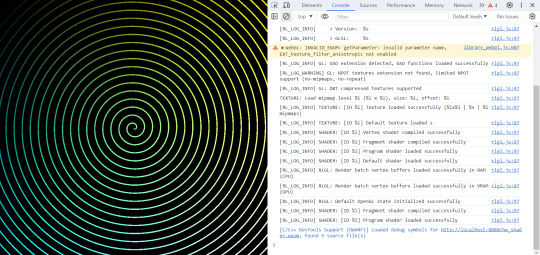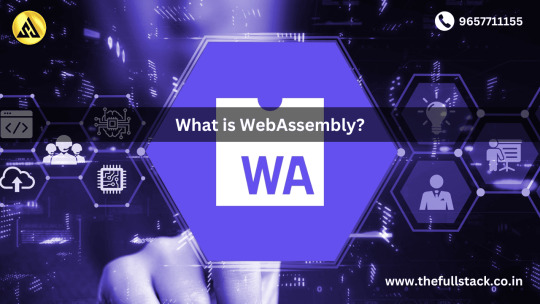#WASM
Explore tagged Tumblr posts
Note
I’m a long standing WP user as well and one of the aspects that I’ve loved about wordpress has been the ability to customize so much of my blog, particularly adding widgets and extensions that have been developed and tested by the community. Is there any momentum in cross-pollination, if you will, of features that have worked well in WP (and vice versa)?
Really appreciate your kindness in answering these questions. Your post last year about your visions for tumblr and automattic was inspiring and I’m hopeful for the future.
I would like to give Tumblr users as much flexibility as you do in the WP ecosystem, and there is some really cool tech being developer that drastically lowers the cost of that flexibility, like WordPress Playground, which spins up a full WP install in real-time in your browser, with WASM. You don't need a database server, etc, anymore. This is truly revolutionary, and we haven't begun to see the impact. Now making that an accessible product is tricky, kind of like we had transformers and LLMs for years but it was the RLHF and product work OpenAI did that blew up that space, really made people reimagine what was possible. That's what we're working on.
129 notes
·
View notes
Text

A bit of proof that I got Pyodide to load off the esp32 server. So soon I'll write the adapter to get PierMesh running using the browser as a processing environment
I use the Pyodide example below the cut but point to the local server instead
12 notes
·
View notes
Text

i spent the last two days making a compatibility layer-ish thing for running simple c programs with rlgl on wasm, without having to use a fucking 1.2GB compiler
but neocities doesn't allow wasm files, so i'll have to host that externally,, on github pages perhaps??
9 notes
·
View notes
Text

I gave WASM a go, with a rough doom-style render. I'm not sure if I'll develop it further, but its nice to know something like this is do-able in browsers
2 notes
·
View notes
Text
Endor: WebAssembly-Based Server in the Browser - The New Stack
0 notes
Text
𝐄𝐱𝐩𝐥𝐨𝐫𝐢𝐧𝐠 𝐭𝐡𝐞 𝐈𝐧𝐭𝐞𝐫𝐬𝐞𝐜𝐭𝐢𝐨𝐧 𝐨𝐟 𝐏𝐨𝐥𝐤𝐚𝐝𝐨𝐭, 𝐍𝐞𝐚𝐫 𝐏𝐫𝐨𝐭𝐨𝐜𝐨𝐥, 𝐚𝐧𝐝 𝐂𝐮𝐭𝐭𝐢𝐧𝐠-𝐄𝐝𝐠𝐞 𝐑𝐞𝐬𝐞𝐚𝐫𝐜𝐡
WebAssembly (WASM) is transforming the way developers approach web development and decentralized applications. With its promise of speed and scalability combined with the robustness of blockchain technology, WASM has become a vital tool in the ecosystems of Polkadot and Near Protocol—two of the most innovative platforms today. This blog post will examine how WASM is applied within these technologies, backed by statistical insights, research findings, and expert opinions.
The Rise of WebAssembly
WebAssembly, or WASM, is a binary instruction format that enables code execution on web browsers at nearly native speed. Since its introduction, WASM has seen rapid adoption across blockchain technologies. A report by the W3C states that more than 90% of modern web browsers now support WASM, leading to an upswing in its usage.
Research published in Blockchain Technology found that utilizing WASM can enhance the performance of decentralized applications (DApps) by anywhere from 10% to 20% compared to traditional JavaScript. This improvement is crucial for platforms like Polkadot and Near Protocol where speed and efficiency can make or break application success.
Polkadot: A Layered Architecture with WASM
Polkadot is at the forefront of blockchain innovation, offering a unique multi-chain architecture that allows different blockchains to operate together seamlessly. A key component of this technology is its use of WASM, empowering developers to write smart contracts in various programming languages, including Rust and C.
Recent statistics reveal that Polkadot's parachains are now processing over 1 million transactions each month. WASM is a significant driver behind this growth, providing lower latency and higher throughput. Data from Parity Technologies, the team behind Polkadot, shows that WASM has demonstrated a performance boost averaging 40% in microbenchmark tests.
The modular design of WASM affords easy upgrades and enhancements, enabling developers to adapt applications quickly to user needs. This flexibility has attracted over 200 active developers to the Polkadot ecosystem, as highlighted in a report from Dev.to.
Near Protocol: Emphasizing Usability and Accessibility
In contrast, Near Protocol prioritizes usability and developer experience, making blockchain technology more approachable for a broader audience. WASM serves a crucial role in this effort, allowing developers to build applications with speed and ease without compromising performance.
According to Near Protocol's reports, DApps built with WASM have seen a staggering 300% increase in user interactions compared to applications developed with traditional smart contract languages. This surge highlights how WASM simplifies the development process, enabling programmers to use familiar languages like AssemblyScript and Rust.
Additionally, the Near Protocol Foundation has invested in educating developers on how to utilize WASM. Their comprehensive guide has already been downloaded by more than 10,000 developers globally, illustrating the strong interest in WASM integration.

Research-Oriented Insights on WASM Adoption
Research consistently highlights the pressing need for innovative technologies like WASM to overcome existing blockchain challenges. A study in the Journal of Computer Science noted that 73% of developers believe WASM enhances their overall development experience. This aligns with findings in the Polkadot and Near ecosystems, where WASM promotes more efficient coding practices.
Organizations like the WebAssembly Community Group are emphasizing widespread adoption across various sectors. A recent survey revealed that 62% of developers working with blockchain technology actively explore incorporating WASM in their projects.
The collaboration between Polkadot and Near Protocol enhances the impact of WASM, as each project contributes its strengths. This partnership can lead to a more resilient, scalable, and user-friendly architecture.
The Future of WASM in Blockchain Technologies
The future of WASM in blockchain technologies is exceptionally bright, especially as Polkadot and Near Protocol continue to innovate. In 2023 alone, over $30 billion has been invested in blockchain research, highlighting the demand for solutions that are faster and more efficient.
According to a report from Deloitte, the need for faster transaction speeds and efficient programming solutions in blockchain will rise by 40% over the next five years. Thus, WASM could be the key technology driving this change.
Future advancements in WASM, including potential integration with AI-driven development tools, could further reinforce its role as a cornerstone of blockchain technology. These enhancements may include features like predictive performance analytics and automated code improvement suggestions.

Final Thoughts
The convergence of Polkadot, Near Protocol, and WebAssembly marks an exciting era for decentralized applications, characterized by speed, adaptability, and improved user experiences. The research, industry growth, and developer engagement clearly show that WASM is solidifying its position in the future of blockchain technologies.
As the landscape continues to evolve, it is evident that the potential for innovation with WASM in platforms like Polkadot and Near Protocol will be pivotal in shaping the next generation of scalable and efficient blockchain applications.
#blockchain#WASM#Polkadot#NearProtocol#dApps#decentralizedapplications#programming#speed#scalability#developerexperience
0 notes
Text
Front-End Programming Languages You Should Learn
As web development continues to evolve, mastering the right front-end programming languages is crucial for staying ahead in the industry. Whether you’re a beginner or an experienced developer, learning the most in-demand front-end languages can help you create dynamic, user-friendly, and high-performing websites. In this guide, we’ll explore the top front-end programming languages you should…
#angular#CSS#front-end programming#HTML#Javascript#jquery#react#sass#vue#WASM#Web Design#web development#WordPress
0 notes
Text
What is WebAssembly?
You’ve undoubtedly heard about WebAssembly (commonly shortened to WASM) if you’re new to web development. What is it, though, and why is it so revolutionary in the field of web development?. read more

#WebAssembly#Wasm#Tech#WebDevelopment#Coding#JavaScript#Cplusplus#Rust#Performance#WebApp#SoftwareDevelopment#OpenSource#FutureOfWeb
0 notes
Text
Leveraging the power and portability of WebAssembly, Extism is an off-the-shelf plug-in system just a library import away. Call plug-ins written in WASM from a number of host languages, such as Java, JS, Rust, and others.
0 notes
Text
6 Best WebAssembly Tools: A Developer's Toolkit

WebAssembly (Wasm) is a revolutionary innovation for the web development industry. Developers involved in any field can now use Wasm to build apps with the same speed and performance as the native applications and even offer great performance. To utilize the advantages of Wasm, developers can pick from a wide range of tools and frameworks.
6 Best WebAssembly Tools
1. Emscripten
Compiler: Emscripten is a powerful tool that enables the direct web application of all the C/C++ codes by converting these codes into web-readable format (WebAssembly modules).
Extensive Features: This software can flexibly support all the C/C++ features and the wide range of libraries makes it one of the best tools in the market for web application development.
2. Rust
Language: Rust is a system programming language that can be transformed into WebAssembly by compiling, therefore, really fast and memory-safe.
Strong Community: Rust is an expanding and faithful community, which means it has plenty of resources and support.
3. AssemblyScript
TypeScript-Like Syntax: AssemblyScript is a syntax that is very close to TypeScript. Of course, it functions perfectly for JavaScript developers.
High Performance: The most and the ideally optimized WebAssembly code will be compiled ensuring that the performance will be, at least, satisfactory under normal circumstances.
4. WebAssembly Studio
WebAssembly Studio the online tool is an IDE that allows the development of WebAssembly modules, which can then be easily tested.
Functions: A feature that enables code editing, debugging, and performance analysis.
5. Binaryen
Optimizer: Binaryen has been developed as a compiler infrastructure for WebAssembly which is supplied with optimization tools focused on better code performance.
Flexibility: This product favors a multitude of different practices, including compilation, optimization, and analysis.
6. WasmEdge
Runtime Environment: WasmEdge is aimed at a lightweight and portable solution to run WebAssembly applications.
Security: Being equipped with the necessary security protections, it can thus be utilized for applications carrying highly sensitive data.
After WebAssembly, people who loved coding would be able to design these marvelous tools and how they would interact with the web. The tools you choose can let WebAssembly be fully released and you can make high-performance web apps.
0 notes
Text
What is Wasm By Example?
"Wasm By Example is a concise, hands-on introduction to WebAssembly using code snippets and annotated WebAssembly example programs. Learn more about Wasm at the WebAssembly Introduction..."
0 notes
Text
For my We(b)OS project (browser based os) I think BVFS can handle FS functionality but as far as logic I'll rely on compiled WASM functions to handle this (outside of simple core functionality), this will make it so everything runs from js natively with no dependencies and Id be able to load additional functions via networking, I think my main concern at this point would be a desktop environment which I think I can handle through canvas element code. Also I think a base "image" should be available over LoRa and loaded in under 5 minutes if Im estimating correctly
11 notes
·
View notes
Note
whats ur beef with wasm

I'd like to thank the Consortium, my siblings HTML and Javascript, my beloathed enemy webasm. Without all of you, I could never have made it to where I am today. Except for you webasm, go to hell.
26 notes
·
View notes